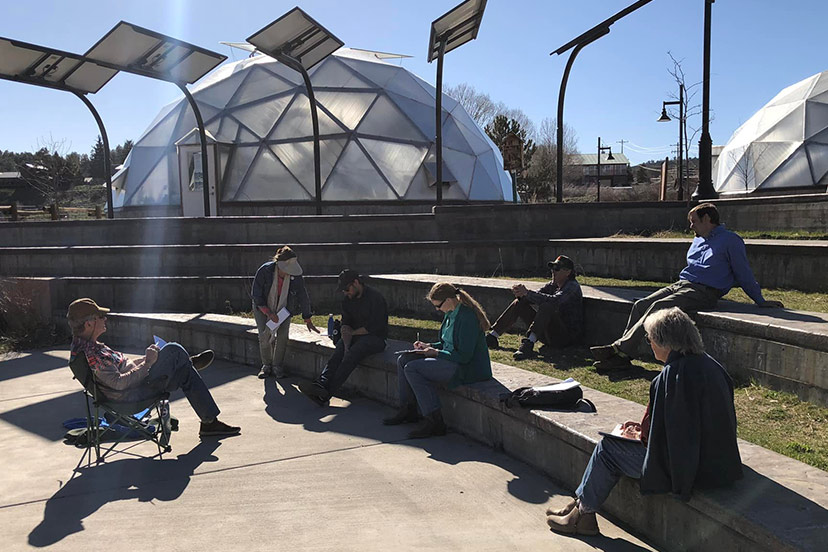Photo: The Geothermal Greenhouse Partnership’s complex in downtown Pagosa Springs.
Last Thursday, a local geothermal expert, Kirsten Skeehan, and Courtney King, an architect, met with the Growers and Producers Forum and community members to discuss potential access to hot water energy and growing food year-round in heated greenhouses. Both speakers are well versed in accessing geothermal energy, such as those used by the Town of Pagosa Springs and the Geothermal Greenhouse Partnership greenhouse domes.
Sponsored by Healthy Archuleta, this meeting took place at the Ruby Sisson Memorial Library.
Kirsten presented slides pertaining to the location of a number of public geothermal wells in Archuleta County, and the history, depth, and temperature of these wells. She also discussed some of the hurdles in exploring for potential geothermal wells. As interest grows and efforts continue to search for clean energy sources, there is a realization that some natural resources, geothermal energy in particular, have valuable benefits to our local agricultural industry. Living in a mountain community and experiencing a short growing season, it is difficult to provide fresh produce year-round. However, with the development of technologies in harnessing geothermal energy, it has been proven that crops can be grown inside heated greenhouses in the deepest parts of winter.
Courtney King demonstrated this concept as she shared slides of her recent trip to Iceland, a small but highly volcanic land mass roughly about the size of the State of Kentucky. She mentioned some of the ways in which the Icelandic population utilizes this natural resource in their cooking and baking, heating, and growing root crops, which they have been doing for hundreds of years. More recently, Iceland has used geothermal energy by building large greenhouses over areas where the heat can be accessed.
Tourism, just like in Pagosa Springs, benefits through access to geothermal water, and geothermal power plants provide clean, cheap energy to Icelandic households. They are now building greenhouses situated over the ground with direct access to the heated waters. In one example, a local tomato grower has produced two tons of tomatoes in a single year. The heated water is piped directly into some of their local restaurants, growing produce such as cucumbers, strawberries, bananas, roses, and peppers onsite to be used in their menus.
The matter of looking at geothermal energy in Archuleta County is double-sided. According to Kirsten, the initial start-up for anyone looking into this resource is first to consider where the energy is located. There are a number of areas in the county that fall under State and local conservation authority. The other issue is cost. It can be very expensive to dig a well to access geothermal waters. However, once the wells have been completed, the operational costs are low. It becomes a never-ending access to clean energy to heat greenhouses and other structures at minimal expense. This potential provides anyone wishing to grow food, either commercially or just for themselves, a way to do so regardless of climate conditions.
There are a number of websites that provide more information about access to geothermal energy in our state. Visit the Colorado School of Mines website at https://www.mines.edu/, the Colorado Energy Office at https://energyoffice.colorado.gov/, or the Colorado Geological Survey at https://coloradogeologicalsurvey.org/.
To learn more about the efforts of Healthy Archuleta, please visit our website at www.foodcoalition4archuleta.org or send us an email at fsfearchuleta@gmail.com

